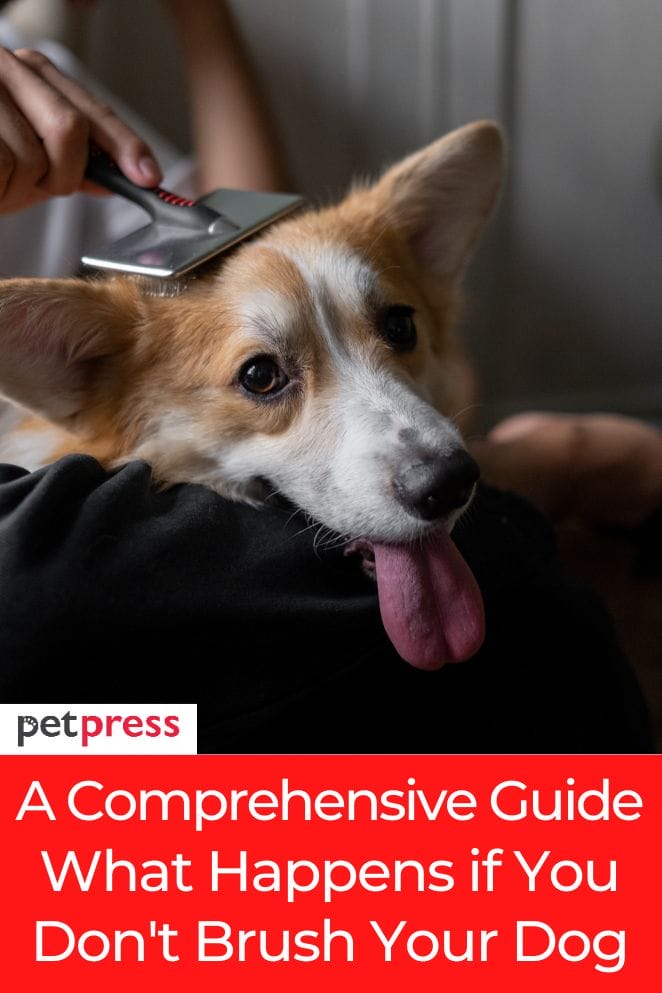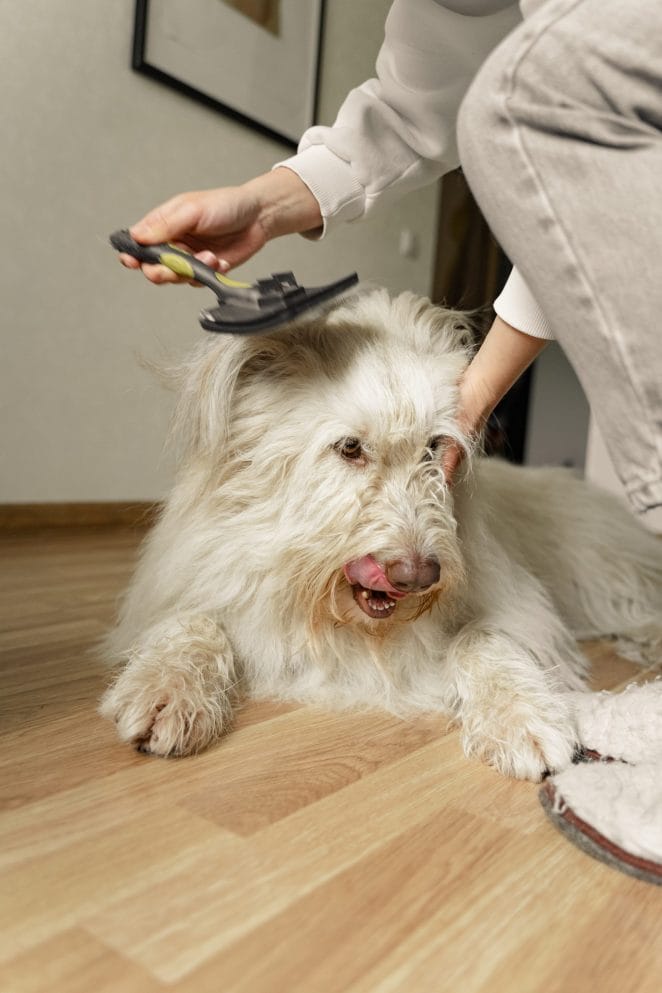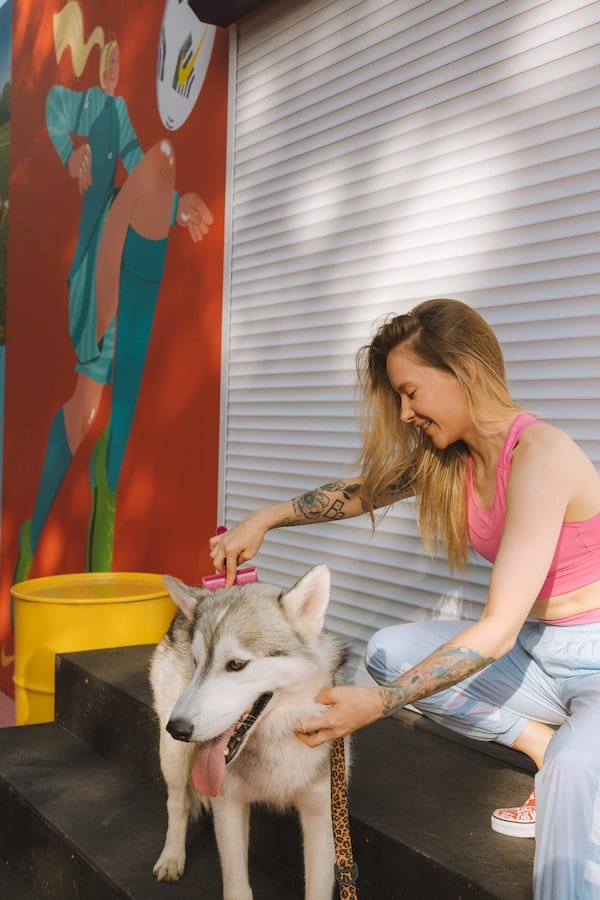
Regularly brushing your dog’s fur is crucial for maintaining good health and overall well-being.
It’s unfortunate that some pet owners only realize its significance when it’s too late.
Brushing your dog’s fur is an essential part of responsible pet care that contributes to their happiness and health.
Without regular brushing, these items can build up in your dog’s fur, leading to a host of problems.
In this blog post, we will discuss the consequences of not regularly brushing provide recommendations for how often you should do it, and offer advice on how to make the process more comfortable and enjoyable for you and your pet.
What happens when you don’t brush your dog?

Neglecting to brush your dog can lead to several issues, including:
Matting
Matting occurs when a dog’s fur becomes tangled and knotted.
This is caused by dirt, dust, and debris that accumulate in the coat if it’s not regularly brushed out.
Matting can be uncomfortable for dogs and cause skin irritation since their fur pulls tightly on their skin.
It can also lead to hair loss or even infection.
In severe cases, matting can cause your dog a lot of discomfort and pain and make it difficult for them to move freely.
Shedding
Without regular brushing, dogs tend to shed more than usual since the natural oils in their fur aren’t evenly distributed.
This can lead to excess, uncomfortable shedding that can cause skin irritation if left unchecked.
It can also lead to an increase in hair around your home and on furniture.
Parasites
Unbrushed fur is more susceptible to parasites such as fleas and ticks.
Since these parasites feed on the oils in your dog’s coat, they can quickly take over if it’s not regularly groomed.
Not only does this cause discomfort for your pup, but it can also lead to other health issues like skin problems and even anemia from blood loss.
Plus, if left unchecked, these parasites can spread to other animals and humans.
Skin problems
Dogs with unbrushed fur are more likely to develop skin problems.
Dirty fur can cause your pup’s skin to become irritated and itchy, leading to potential infection or abscesses due to scratching and biting at the affected area.
In some cases, they may even develop rashes from their own fur and dander.
Regular brushing can help keep your pup’s skin healthy and free from any of these issues.
Odor
Finally, a neglected fur coat can lead to an increase in an unpleasant odor.
This is due to the dirt, debris, and sweat that builds up in your pup’s fur if it has not been brushed regularly.
Not only is this uncomfortable for you both, but it can also make them more likely to attract predators in the wild.
How often should you brush your dog?

The frequency with which you should brush your dog depends on its breed, coat type, and individual needs. As a general guideline:
Short-haired breeds
Short-haired breeds need to be brushed at least once a week. This will help reduce shedding and prevent matting from forming in their coats.
It’s also important to inspect your pup’s skin during these sessions for any signs of irritation or parasites.
Long-haired breeds
Long-haired breeds need to be brushed more frequently than short-haired ones, usually every other day.
This is especially important during the spring and summer months when they shed even more than usual.
Taking the time to brush your pup’s fur can help reduce shedding and keep their coat looking shiny and healthy.
Tips for brushing your dog

Brushing your pup’s fur can be a pleasant experience for both of you if done correctly. Here are some tips to make the process easier and more enjoyable:
Choose the right brush
The type of brush you use is important, as it can make a big difference in how your pup perceives brushing.
Be sure to choose a brush that’s designed specifically for your pup’s coat type and length.
Be gentle
No matter what type of brush you use, it’s important to be gentle when brushing your pup’s fur. Start at the neck and move down to the tail in slow, even strokes.
Take care not to press too hard on your pup’s skin, as this can cause discomfort and irritation.
Use treats
Using treats during brushing time can be a great way to make the process more enjoyable for both you and your pup.
For dogs who are especially resistant to being brushed, offering a treat after each session can help them associate the activity with something positive.
This can make it much easier to get your pup used to regular brushing sessions.
Start early
It is recommended to start introducing your dog to brushing when they are young to help them get comfortable with it.
As your pup gets used to being brushed, you can start gradually increasing the time and frequency of brushing sessions.
This will help ensure that your pup is always well-groomed and comfortable.
Be consistent
Finally, it’s important to be consistent when it comes to brushing your pup. This will help ensure that their fur stays clean and healthy.
Try to establish a regular routine for brushing and stick to it as much as possible.
With consistency, you can make sure that your pup’s coat is always looking its best.
Conclusion
Brushing your dog is an essential part of maintaining their overall health and well-being.
Neglecting this task can lead to matting, skin problems, excessive shedding, unpleasant odors, and a weakened bond between you and your pet.
By understanding the importance of regular brushing, choosing the right tools, and following our tips, you can ensure that your dog stays happy, healthy, and well-groomed.


GIPHY App Key not set. Please check settings